Kia Seltos is the company’s first car for India and they leaves no stones unturned to make a grand entry armed with great styling and several segment-first features. And, finally, we drove the mid-sized SUV in Goa.
Being a sister-brand of Hyundai, the Kia Seltos is based on the next-gen Creta platform and both the cars borrow some parts from the common basket. The new petrol and diesel engine options that the Kia Seltos has brought with it will be used in the BS-VI version of the Creta which will be launched next year.
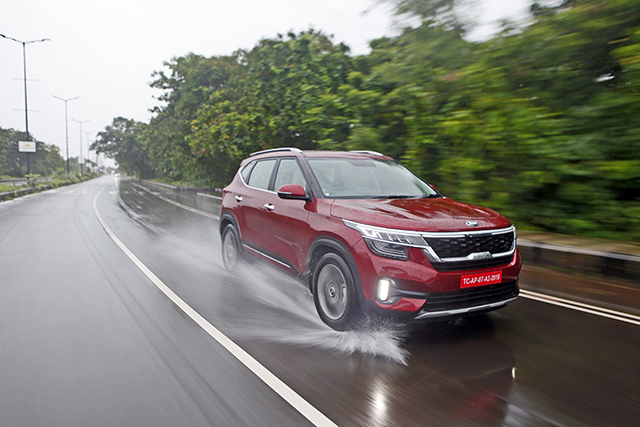
Design
Its design is the Kia Seltos’ strongest aspect. There’s an aura of confidence with bold creases and sharp lines, the highlight being the sweeping headlamps which get the “crown jewel”-inspired lighting and the unmistakable tiger-nose grille. Chrome highlights, a shiny black grille, brush metal highlights and vertically stacked “ice-cube” fog-lights create a strong front design. There are two trim lines to choose from: the standard Tech Line and the more youth-oriented GT Line. The GT gets red highlights on the sump-guards and the side cladding, 17-inch crystal cut alloy wheels with red brake calipers, and even some GT badging.
I prefer the side profile with clean lines and play of colours. The contrasting black bodywork and chrome accents bring out the body colour, while the black A-pillar creates the floating roof impression very well. Sleek roof-rails, a shark-fin antenna, and the spoiler look sporty, along with the sharp tail-lamp design and the faux twin-exhaust on the rear bumper. Overall, it’s a refreshing take on a crossover design by Kia, something for which the brand is well appreciated worldwide.
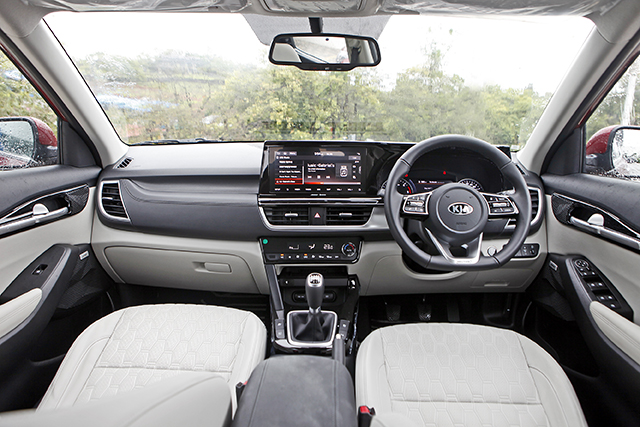
Interior
The cabin has a distinct Kia aura which is very different from what we’ve seen in the Creta. The sharp rectangular console on the dashboard, which houses the driver’s information display and the large touchscreen of our top-of-the-line trim test cars, makes it stand apart. Premium beige-and-black treatment of the cabin looks nice, while the GT Line buyers can opt for an all-black cabin with red contrast stitching and sportier seat upholstery. My pick would be the hexagonal stitching on the seats of the Tech Line.
The door-panels get an interesting fractal pattern which comes with mood lighting and there’s ample space to stow water bottles. The numerous cubbyholes include space for two phones on the centre console and a couple of coffee cup-holders. The quality of materials and craftsmanship is hard to fault.
When compared to the existing Creta, the Kia Seltos is longer by 45 millimetres and wider by 20 mm. Even though the height has gone down by 45 mm, you won’t notice a stark difference in the headroom. Since the wheelbase has been increased by 20 mm, rear-seat passengers are driven in good comfort with ample knee-room and a relaxed sitting position. The rear seat can be inclined a couple of notches to catch a nap on longer drives. There’s no visible cost-cutting as the Kia offers rear a-c vents, centre arm-rest, and segment-first features such as 60:40 split seats and adjustable centre headrest. Moreover, the 433 litres of boot space is about 28 litres more than the Hyundai. It’s Kia’s first car model for India and, clearly, they want to leave no stones unturned.
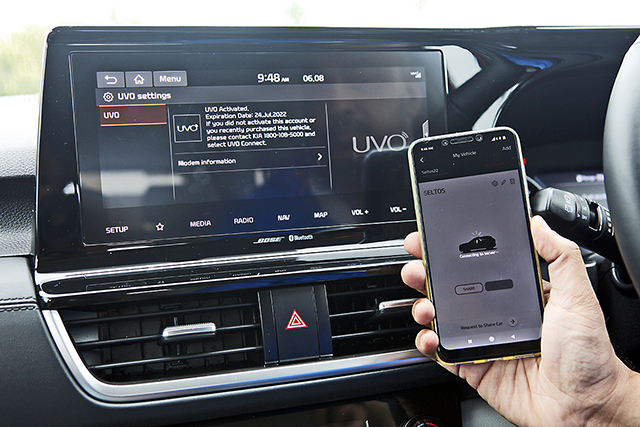
Features
This is going to be a long section because Kia Seltos has so much to offer. To start with, top variants get smart “D” cut (flat bottom) steering wheel, eight-inch heads-up display and eight-way adjustable driver’s seat. The list of features is practically never-ending. It also gets an LG-sourced 10.25-inch touchscreen infotainment system and a very informative driver’s information console with alerts for things such as tyre pressure and even turn-by-turn navigation. The infotainment lets you manage the car’s setting right from the way it delivers the information to control the air-purifier and, of course, making most of the sublime 400-watt, eight-speaker Bose music system. The system monitors the vehicle speed and adjusts the volume automatically. The infotainment system offers split-screen function, an integrated 3D navigation system, and Android Auto and Apple CarPlay connectivity. The other variants get a pretty decent music system from Arkmays.
Since everyone opts for connected cars these days, Kia have joined hands with Vodafone and Amazon cloud to bring UVO Lite and UVO Connect services to India. The UVO Lite mobile app allows the owner the convenience to control the sound system through the phone. The UVO Connect has tonnes of features — 37 to be precise. Owners get three years’ free subscription that includes navigation, safety and security, vehicle management, remote control, and convenience. I’m sure you don’t want me to list all of them here right now, but the highlights for me are obviously reliable navigation with live traffic updates and the fact that the car’s key comes with a panic button which alerts the company’s call centre and sends an SMS notification to the pre-set emergency contacts. You can share your car’s location with others and set up geo-fence and speeding alerts. In case your car gets stolen, it can be tracked and you can even remotely immobilize it to foil the thief’s getaway plan. Yes, my hunch is that Kia have hired the talented Mr Q from the James Bond series.
In terms of features, the Seltos is nearly perfect. Just that the front passenger seat can only be adjusted manually. And since the seat height can’t be altered, it feels rather high. I found that the automatic climate control, which has been enhanced for India, did a good job of cooling the cabin. Perhaps, Kia could have opted for greater flexibility in the passenger seat instead of making it perforated with cooling vents. The good news is that the Seltos gets an air-purifier which is neatly integrated within the front arm-rest and has a display for rear-seat passengers.
[metaslider id=22998]
Engine and Performance
It’s evident in the powertrain lineup as well: two new petrol engines and a new diesel. All of them efficient, clean, and ready for BS-VI switchover right from launch. I got a chance to sample all of them briefly at Kia’s test-track earlier (Read about it here), but in Goa I focused on the 1.4-litre petrol seven-speed DCT petrol and the 1.5-litre manual diesel versions only owing to time constraints.
If you prefer an enthusiastic drive, then look at the peppy 1.4-litre GDI version. This four-cylinder turbo-charged petrol punches out 140 hp at 6,000 rpm and has an impressive torque output of 242 Nm which peaks between 1,500 and 3,200 rpm. This gives the car a nice and meaty mid-range and outright performance but has to be revved hard to get most out of it. The turbo-petrol can be had with a smooth-shifting six-speed manual or a modern seven-speed dual-clutch transmission.
Obviously, the DCT version will demand quite a premium compared to the other variants of the Kia Seltos, but it remains the most desirable option simply because it has the best mix of performance and convenience. More premium because it comes packed with features, including Drive and Traction modes. The Traction modes include Mud, Wet, and Sand which alter the throttle response and ABS set-up. The Sport driving mode alters the engine, gear-shifts, and steering feel to make it more engaging to drive. However, in the city, Sport mode feels a little too aggressive and almost jumpy. Step on the gas and it makes the engine rev harder but there’s a slight lag before the spike of power reaches the wheels. I suggest you reserve Sport for highways where you can enjoy brisk acceleration and the sporty exhaust note.
Normal mode is better suited for regular commuting with its seamless power delivery. It’s a free-revving engine that can be revved all the way to its 6,800-rpm red-line. The meaty torque helps disguise the turbo spike while the DCT selects the right gear for the occasion. Kia engineers claim that the 1.4-litre GDI can sprint from 0 to 100 km/h in just 9.7 seconds and it surely feels quick. Interestingly, the seven-speed DCT is said to be slightly more efficient than the manual version as it returns 16.5 km/l while the latter manages 16.1 km/l (claimed figures). We are extremely keen to test the performance and efficiency when we get the car for a road test.
On to the diesel variant now. The 1.5-litre VGT makes 115 hp at 4,000 rpm and, in my opinion, it is one of the best oil-burners in the segment currently. It’s extremely refined and responsive even at low revs. In fact, it feels almost petrol-like. Being a diesel, the VGT is also frugal and its biggest virtue is that it’s so effortless to drive. The 250 Nm of torque flows in early, being available from 1,500 rpm, and remains flat so you can ride on that wave till the revs come close to the red-line. Then there’s the option of buying either a six-speed manual or opting for the six-speed torque converter, both of which dish out linear power delivery and brisk performance. Kia claim 0-100 km/h in a respectful 11.5 seconds. Like the other automatic variants of the Seltos, the diesel AT also gets three driving modes along with traction control settings.
In the manual ‘box version, the clutch felt light and convenient, but the gear-shifts could have been slicker. The gearing itself, however, is tall and you can stay in second gear and manage city speeds without the need of shifting to third. And that’s one of the reasons why this is the most frugal variant of the Seltos, with a claimed efficiency of 21 km/l, which is three km/l more than the diesel AT version. This 1.5 VGT is a complete all-rounder which will live up to your demands, be it city or highway, efficiency or performance.
Ride and Handling
The three engine options have similar suspension systems, but the set-ups are a tad different. The petrol versions felt a bit softer sprung compared to the diesel; the latter felt tauter and more composed. This is another reason why I enjoyed driving the Kia Seltos diesel even more. All the three versions offer fairly decent ride quality and passenger comfort, but the rear suspension set-up is on the firmer side for our road conditions. The steering is light and effortless to use and, though it’s not too communicative, it doesn’t feel dull. While carrying a decent speed through corners, it showed little traces of understeer, but the steering felt precise and quick to my inputs.
Another massive improvement is in the brakes as compared to the Hyundai Creta. The Seltos has disc brakes on all four wheels (12-inch front, 10-inch rear) which give it a confident bite. The engineers have also worked on the mechanism to reduce juddering during hard braking. The crossover remains pretty composed at higher speeds due to the low 0.35 drag coefficient achieved through a more aerodynamic underbody design.
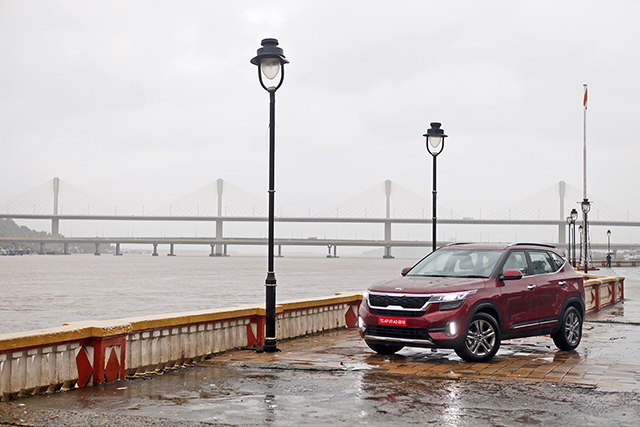
Conclusion
These numerous improvements and segment-first features make the Kia Seltos a very promising car. Now the segment will have to play catch-up as Kia won’t give others an easy fight and will price it on a par with the competitors. If you’ve put on hold your new car purchase waiting for the Kia Seltos, we think you made a smart decision.


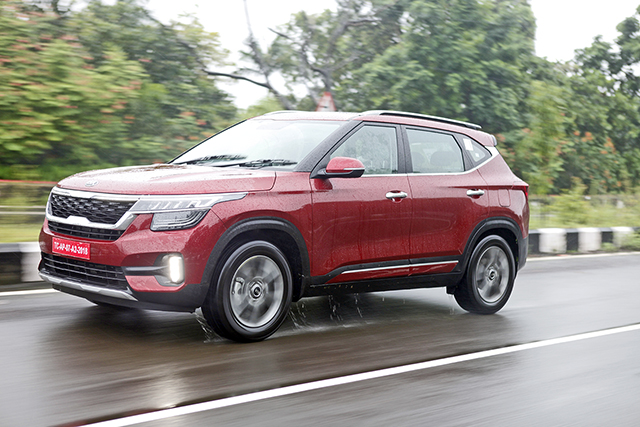



















Leave a Reply